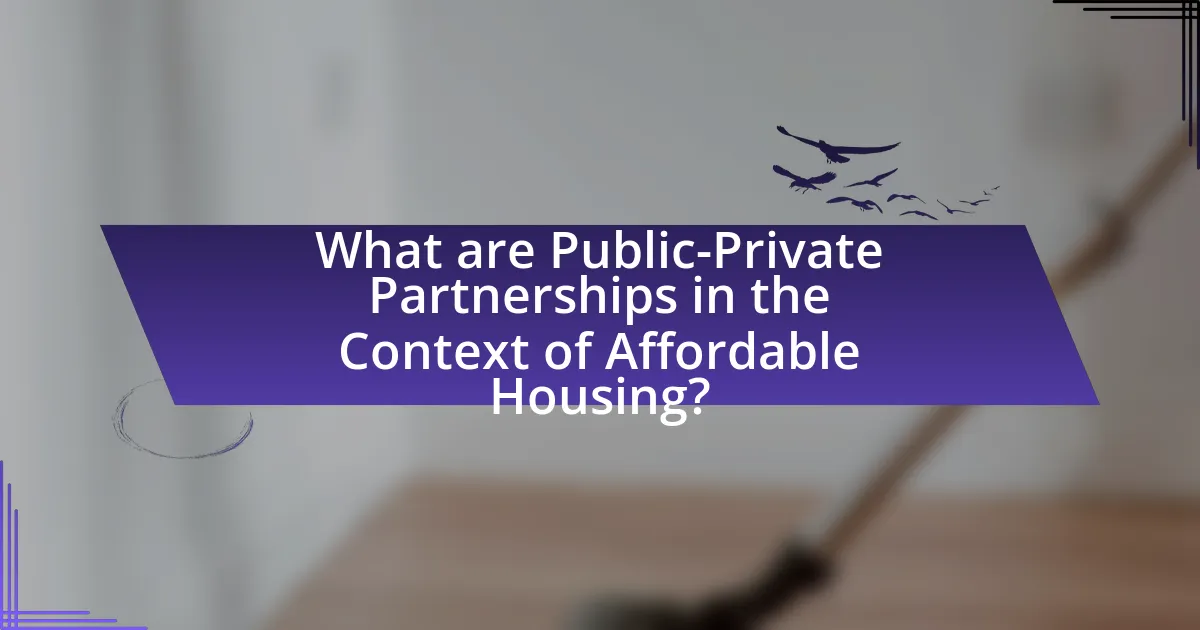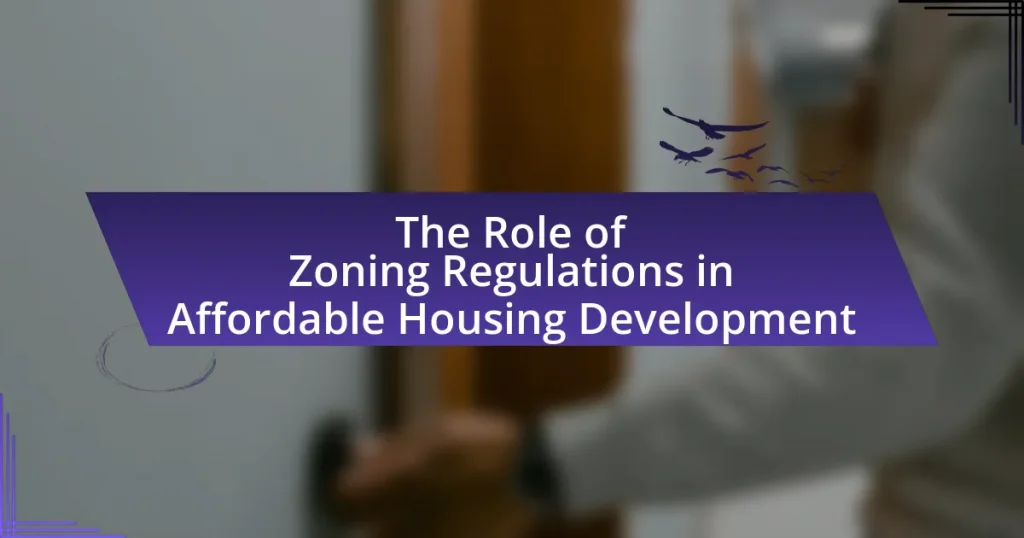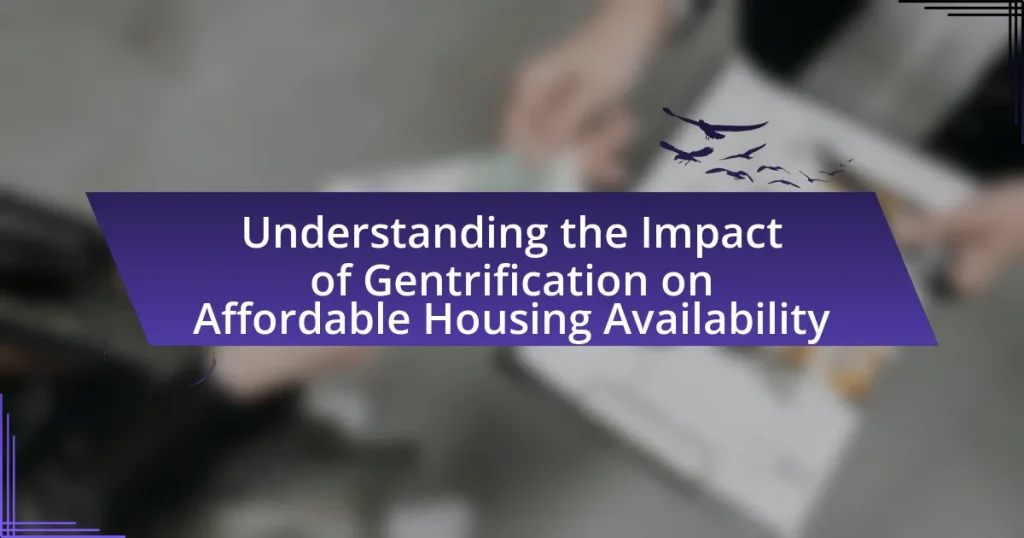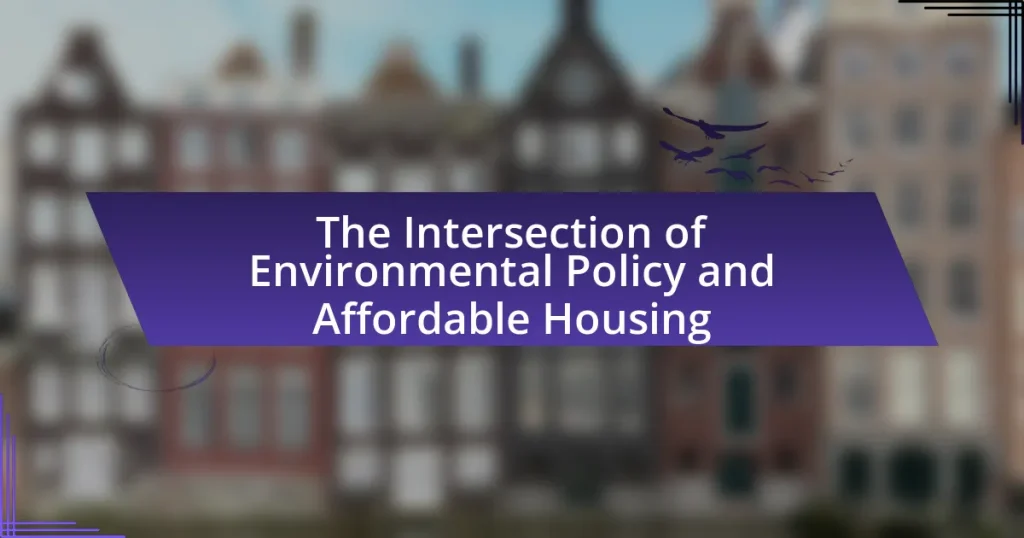Public-Private Partnerships (PPPs) play a crucial role in addressing affordable housing challenges by combining resources and expertise from government entities and private developers. This article explores the functioning of PPPs in affordable housing initiatives, highlighting key components such as shared risk, investment, and expertise. It examines historical developments, benefits, challenges, and best practices associated with these partnerships, as well as their impact on community development and sustainability. Additionally, the article discusses future trends and emerging models in affordable housing, providing practical steps for stakeholders to enhance the effectiveness of PPPs in meeting housing needs.

What are Public-Private Partnerships in the Context of Affordable Housing?
Public-Private Partnerships (PPPs) in the context of affordable housing are collaborative agreements between government entities and private sector companies aimed at developing, financing, and managing affordable housing projects. These partnerships leverage the strengths of both sectors; the public sector provides regulatory support and funding, while the private sector contributes expertise, efficiency, and capital investment. For instance, according to the National Council for Public-Private Partnerships, these collaborations can lead to the creation of more than 1 million affordable housing units in the United States, demonstrating their effectiveness in addressing housing shortages.
How do Public-Private Partnerships function in affordable housing initiatives?
Public-Private Partnerships (PPPs) function in affordable housing initiatives by combining resources and expertise from both the public and private sectors to develop, finance, and manage housing projects. These collaborations leverage public funding and regulatory support alongside private investment and innovation, resulting in increased efficiency and reduced costs. For instance, a study by the Urban Institute highlights that PPPs can expedite project timelines and enhance the quality of housing through shared risk and responsibility. By aligning the goals of both sectors, PPPs facilitate the creation of affordable housing that meets community needs while ensuring financial viability for developers.
What are the key components of Public-Private Partnerships in this sector?
The key components of Public-Private Partnerships (PPPs) in the affordable housing sector include shared risk, investment, and expertise. Shared risk involves both public and private entities collaborating to distribute financial and operational risks associated with housing projects. Investment refers to the financial contributions made by both sectors, where private entities often provide capital while public entities may offer land or subsidies. Expertise is crucial, as private partners typically bring innovative construction methods and management practices, while public partners contribute regulatory knowledge and community insights. These components work together to enhance the efficiency and effectiveness of affordable housing solutions, as evidenced by successful PPP projects that have increased housing availability and reduced costs in various regions.
How do these components interact to facilitate affordable housing?
Public-private partnerships (PPPs) facilitate affordable housing by combining resources, expertise, and risk-sharing between government entities and private developers. These collaborations enable the pooling of financial resources, allowing for the construction and maintenance of housing units at lower costs. For instance, government incentives such as tax credits and grants can attract private investment, while private developers bring efficiency and innovation to project execution. According to the National Council of State Housing Agencies, states that utilize PPPs for affordable housing have seen a 20% increase in housing units developed compared to those that do not. This synergy between public and private sectors effectively addresses the housing shortage and enhances affordability for low-income families.
What are the historical developments of Public-Private Partnerships in affordable housing?
Public-Private Partnerships (PPPs) in affordable housing have evolved significantly since their inception in the mid-20th century. Initially, in the 1960s and 1970s, governments primarily funded public housing projects, but financial constraints led to the exploration of private sector involvement. The 1980s saw the introduction of tax incentives and subsidies to encourage private investment in affordable housing, exemplified by the Low-Income Housing Tax Credit program established in the United States in 1986.
By the 1990s, the concept of PPPs gained traction globally, with countries like the UK implementing the Private Finance Initiative (PFI) to leverage private capital for public housing projects. This trend continued into the 2000s, where innovative financing models emerged, such as joint ventures and social impact bonds, aimed at addressing housing shortages while ensuring affordability.
Recent developments, particularly post-2008 financial crisis, have emphasized the need for sustainable and resilient housing solutions, prompting governments to further integrate private sector expertise and resources into affordable housing strategies. This historical trajectory illustrates the increasing reliance on PPPs as a viable solution to the persistent challenges of affordable housing.
How have these partnerships evolved over time?
Public-private partnerships in affordable housing have evolved from traditional government-led initiatives to more collaborative models that leverage private sector efficiency and innovation. Initially, these partnerships focused primarily on funding and construction, with public entities providing land and financial support while private firms handled development. Over time, the approach has shifted to include shared risk and responsibility, with private partners increasingly involved in long-term management and maintenance of housing projects. This evolution is evidenced by the rise of mixed-income developments and inclusionary zoning policies, which integrate affordable units within broader market-rate projects, reflecting a more holistic strategy to address housing needs. Additionally, data from the National Council for Public-Private Partnerships indicates that such collaborations have expanded in scope, now encompassing not only construction but also community engagement and sustainability initiatives, demonstrating a comprehensive approach to affordable housing solutions.
What lessons can be learned from past Public-Private Partnerships in housing?
Past Public-Private Partnerships (PPPs) in housing demonstrate that effective collaboration can lead to increased efficiency and innovation in affordable housing development. For instance, the partnership between the New York City Housing Authority and private developers resulted in the creation of over 10,000 affordable units, showcasing how shared resources and expertise can address housing shortages. Additionally, these partnerships highlight the importance of clear contractual agreements and accountability measures, as seen in the UK’s Housing Partnerships, which improved project delivery timelines by 30% when roles and responsibilities were well-defined. Furthermore, successful PPPs often incorporate community engagement, ensuring that housing solutions meet the needs of local populations, as evidenced by the participatory approach taken in the San Francisco Bay Area, which led to higher resident satisfaction rates.
What are the primary benefits of Public-Private Partnerships for affordable housing?
Public-Private Partnerships (PPPs) for affordable housing primarily benefit communities by leveraging resources, expertise, and risk-sharing between public entities and private developers. These collaborations enhance funding opportunities, as private investment can supplement limited public budgets, leading to the construction of more affordable units. For instance, a study by the Urban Institute found that PPPs can reduce project costs by up to 30% through efficiencies in design and construction processes. Additionally, PPPs often result in innovative housing solutions that meet local needs more effectively, as private partners bring market-driven approaches and technology to the table. This synergy not only accelerates project timelines but also improves the quality and sustainability of housing developments.
How do these partnerships enhance funding and resource allocation?
Public-private partnerships enhance funding and resource allocation by leveraging the strengths of both sectors to pool financial resources and expertise. These collaborations often result in increased investment in affordable housing projects, as private entities bring capital and innovation while public entities provide regulatory support and access to land. For instance, a study by the Urban Institute found that public-private partnerships can reduce project costs by up to 20% through shared risk and efficient resource management, thereby maximizing the impact of available funding.
What impact do they have on community development and sustainability?
Public-private partnerships (PPPs) significantly enhance community development and sustainability by facilitating the creation of affordable housing solutions. These collaborations leverage resources, expertise, and funding from both sectors, resulting in efficient project execution and innovative approaches to housing challenges. For instance, a study by the Urban Institute found that PPPs can reduce project costs by up to 20% while increasing the speed of development, thereby addressing urgent housing needs in communities. Additionally, sustainable practices integrated into these partnerships, such as green building techniques, contribute to long-term environmental benefits and improved quality of life for residents.
What challenges do Public-Private Partnerships face in affordable housing?
Public-Private Partnerships (PPPs) in affordable housing face several significant challenges, including funding constraints, regulatory hurdles, and alignment of interests. Funding constraints arise because PPPs often rely on both public and private investment, which can be difficult to secure, especially in economically challenging times. Regulatory hurdles include complex zoning laws and building codes that can delay project timelines and increase costs. Additionally, aligning the interests of public entities, which prioritize social outcomes, with private developers, who focus on profitability, can lead to conflicts that hinder project success. These challenges are well-documented in studies such as the “Affordable Housing and Public-Private Partnerships” report by the Urban Institute, which highlights the need for clear communication and shared goals to overcome these obstacles.
What are the common obstacles in collaboration between public and private sectors?
Common obstacles in collaboration between public and private sectors include differing objectives, regulatory challenges, and communication barriers. Public entities often prioritize social outcomes and compliance with regulations, while private companies focus on profitability and efficiency. This fundamental difference can lead to conflicts in project goals and expectations. Regulatory challenges arise from complex legal frameworks that can hinder timely decision-making and project implementation. Additionally, communication barriers, including lack of transparency and differing terminologies, can impede effective collaboration, resulting in misunderstandings and delays. These obstacles can significantly affect the success of public-private partnerships, particularly in sectors like affordable housing, where alignment of interests is crucial for achieving shared goals.
How can these challenges be addressed to improve outcomes?
Public-private partnerships can address challenges in affordable housing by leveraging resources, expertise, and innovation from both sectors. These collaborations can streamline project financing, reduce costs, and expedite the development process. For instance, a study by the Urban Institute found that public-private partnerships can reduce project timelines by up to 30%, allowing for quicker delivery of housing units. Additionally, these partnerships can enhance community engagement and ensure that developments meet local needs, as evidenced by successful projects in cities like San Diego, where stakeholder involvement led to a 25% increase in affordable housing units. By combining the strengths of public oversight with private sector efficiency, outcomes in affordable housing can be significantly improved.
How do Public-Private Partnerships influence policy and regulation in affordable housing?
Public-Private Partnerships (PPPs) significantly influence policy and regulation in affordable housing by fostering collaboration between government entities and private developers, leading to innovative financing and project delivery methods. These partnerships enable the pooling of resources, expertise, and risk-sharing, which can result in the development of affordable housing projects that align with public policy goals. For instance, the U.S. Department of Housing and Urban Development (HUD) has recognized that PPPs can enhance the efficiency of housing programs and increase the availability of affordable units, as evidenced by initiatives like the Low-Income Housing Tax Credit program, which incentivizes private investment in affordable housing. Additionally, PPPs often lead to the establishment of regulatory frameworks that streamline the approval processes for housing developments, thereby accelerating project timelines and reducing costs.
What role do government policies play in shaping these partnerships?
Government policies play a crucial role in shaping public-private partnerships in affordable housing solutions by establishing regulatory frameworks, providing funding incentives, and setting performance standards. These policies can facilitate collaboration between public entities and private developers, ensuring that affordable housing projects meet community needs while adhering to legal and financial guidelines. For instance, policies such as tax credits, zoning regulations, and grant programs directly influence the feasibility and attractiveness of partnerships, as evidenced by the Low-Income Housing Tax Credit program in the United States, which has successfully leveraged private investment to create millions of affordable housing units.
How can regulations be optimized to support effective Public-Private Partnerships?
Regulations can be optimized to support effective Public-Private Partnerships (PPPs) by streamlining approval processes and ensuring transparency in project selection. Streamlined approval processes reduce bureaucratic delays, enabling faster project initiation and execution, which is crucial in the context of affordable housing where timely delivery is essential. For instance, the World Bank has noted that countries with simplified regulatory frameworks for PPPs experience higher investment levels and project success rates. Additionally, ensuring transparency in project selection fosters trust among stakeholders, encouraging private sector participation. Research from the OECD indicates that transparent processes lead to better project outcomes and increased public confidence in PPP initiatives.
What are the best practices for implementing successful Public-Private Partnerships in affordable housing?
The best practices for implementing successful Public-Private Partnerships (PPPs) in affordable housing include establishing clear objectives, fostering strong communication, and ensuring equitable risk-sharing. Clear objectives align the goals of both public and private entities, facilitating a shared vision for the project. Strong communication throughout the partnership enhances collaboration and addresses challenges promptly, as evidenced by successful projects like the New York City Housing Authority’s partnerships, which emphasize ongoing dialogue. Equitable risk-sharing ensures that both parties are invested in the project’s success, reducing the likelihood of conflicts and fostering a cooperative environment, as demonstrated in the case of the Denver Housing Authority’s partnerships, which have effectively balanced risks and rewards.
What strategies can be employed to ensure stakeholder engagement?
To ensure stakeholder engagement, strategies such as regular communication, inclusive decision-making, and transparent reporting can be employed. Regular communication fosters trust and keeps stakeholders informed about project developments, while inclusive decision-making allows stakeholders to contribute their insights and preferences, enhancing their commitment. Transparent reporting on project progress and outcomes builds accountability and reinforces stakeholder confidence. Research indicates that projects with high stakeholder engagement are 20% more likely to succeed, highlighting the importance of these strategies in public-private partnerships for affordable housing solutions.
How can performance metrics be established to evaluate success?
Performance metrics can be established to evaluate success by defining clear, measurable objectives aligned with the goals of public-private partnerships in affordable housing. These metrics should include quantitative indicators such as the number of housing units developed, cost per unit, and occupancy rates, as well as qualitative measures like resident satisfaction and community impact. For instance, a study by the Urban Institute found that successful partnerships often track metrics related to project timelines and budget adherence, which provide concrete evidence of efficiency and effectiveness in delivering affordable housing solutions.
What future trends can be anticipated for Public-Private Partnerships in affordable housing?
Future trends for Public-Private Partnerships (PPPs) in affordable housing include increased collaboration between government entities and private developers, a focus on sustainability, and the integration of technology in housing solutions. As urbanization continues to rise, governments are likely to seek innovative financing models that leverage private investment to meet housing demands. For instance, the World Bank has reported that PPPs can mobilize resources and expertise, which is essential for developing affordable housing projects efficiently. Additionally, there is a growing emphasis on green building practices within these partnerships, as evidenced by initiatives like the Green Building Council’s efforts to promote sustainable construction methods. Furthermore, the adoption of smart technologies in housing developments is anticipated to enhance living conditions and reduce operational costs, aligning with the increasing demand for smart city solutions.
How might technological advancements impact these partnerships?
Technological advancements can significantly enhance public-private partnerships in affordable housing solutions by improving efficiency, reducing costs, and facilitating better communication. For instance, the use of Building Information Modeling (BIM) allows for more accurate project planning and resource allocation, which can lead to a 20% reduction in construction costs and time, as reported by the National Institute of Building Sciences. Additionally, advancements in data analytics enable stakeholders to make informed decisions based on real-time data, optimizing resource management and project outcomes. These technologies foster collaboration between public and private entities, ultimately leading to more effective and sustainable housing solutions.
What emerging models are being explored in the realm of affordable housing?
Emerging models being explored in the realm of affordable housing include community land trusts, modular construction, and co-housing initiatives. Community land trusts enable communities to collectively own land, ensuring long-term affordability and preventing displacement. Modular construction utilizes prefabricated components to reduce costs and construction time, making housing more accessible. Co-housing initiatives promote shared living spaces and resources, fostering community while lowering individual housing expenses. These models are gaining traction as they address the urgent need for affordable housing solutions in various urban settings.
What practical steps can stakeholders take to enhance Public-Private Partnerships in affordable housing?
Stakeholders can enhance Public-Private Partnerships (PPPs) in affordable housing by establishing clear communication channels and aligning objectives. Effective communication fosters collaboration between public entities and private developers, ensuring that both parties understand the goals and constraints of the partnership. Additionally, stakeholders should create incentive structures that encourage private investment, such as tax credits or streamlined permitting processes, which have been shown to attract more developers to affordable housing projects.
Furthermore, stakeholders can implement joint risk-sharing mechanisms to mitigate financial uncertainties, making it more appealing for private entities to engage in affordable housing initiatives. Evidence from successful PPPs, such as the Housing Partnership Network, demonstrates that these strategies lead to increased project viability and sustainability. By focusing on these practical steps, stakeholders can significantly improve the effectiveness of PPPs in addressing affordable housing needs.



